History
Loon Lake - Early Years The Settling of Big Arm
Loon Lake in the Thirties Big Arm Schools
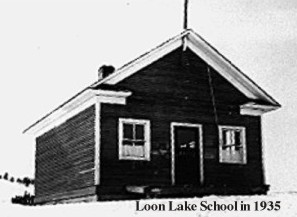
Loon Lake District #42 began November 26, 1910. The original trustees were R. E. Chantry, C. Trogdon, and J. L. Tabor. No clerk was appointed that first year there was no school. Trogdon dropped off the board and David Wishart joined. They appointed D. L. Winchell clerk. He served two years. Mrs. Selma Tabor would be appointed clerk in 1913 and served quite steadily until 1933. J. L. Tabor served the board as trustee for 24 years, last serving in 1938, the last year there was school at the site.
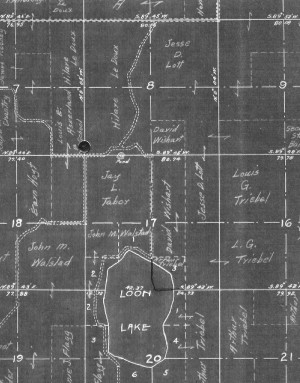 The original 1910 boundaries were soon altered in 1911 by the creation of Big Arm District No. 65, Spring Valley District No. 57 and Blair District No. 45 by the Flathead County Superintendent of Schools. By March of 1911 nine more sections would be transferred to Sunny Slope District No. 46.
The original 1910 boundaries were soon altered in 1911 by the creation of Big Arm District No. 65, Spring Valley District No. 57 and Blair District No. 45 by the Flathead County Superintendent of Schools. By March of 1911 nine more sections would be transferred to Sunny Slope District No. 46.
Pressed for time and material, the settlers cooperated to build Loon Lake schoolhouse and built a church at Big Arm which was also used for a temporary schoolhouse until Big Arm could get their school built. Prior to the opening of the Flathead Reservation for non-tribal settlement, the U. S. government provided school for Indian children, but that was dropped when the new Big Arm school was built.
In 1911-12 Cara B. Ogden taught the first year at Loon Lake School. She was followed by Estella Baumer the next year. Miss Baumer and her sister Maggie lived at Big Arm and Estella never married. A notation in the records of 1913-14 indicates that Mrs. Nellie Trekell taught the school session from September 2 to February 7 and the next year until April. Children must have been needed at home to help establish the homestead. In February of 1914 three more sections were transferred to Sunny Slope.
Edward Hoyt told his wife that when he attended Loon Lake School the teachers boarded and roomed with his family. Edward’s father, Earn Hoyt served on the school board from 1917 to 1931. Their property was 1/4 mile and across the road from the school. Either the Hoyt or Tabor home served as homes for the teachers.
Inez Tabor taught two years at Loon Lake from 1921 to 1923. Bill Tabor was born when his aunt Inez taught at Loon Lake. After that she went and taught at "Jungle School" up toward Walter Jacksons. She married and her name changed to Inez Kielbauch and they moved to the Sweet Grass Mountains outside of Sunburst.
Vernace May McBroom taught at Loon Lake in 1923-24. Most of the students were her own children. Her sons were Wes, Delbert, Dick, Jim, Bob, and Cliff and her girls were Jesse and Elva. Josephine and Effie Wishart also went to school at Loon Lake. Shortly thereafter Herb Vinson started school at Loon Lake. Younger brother Johnny remembers this story about Herb: One time Herb was up in front of the class pulling down the map. He had his finger hooked through the ring. He fainted and down came the map on top of him – ripped it right off the roll.
The Vinson children (George, Robert, Joan, Jean, Herb, John and Amy) rode horseback to school when it was warm and walked the nearly three miles when it was cold. Sometimes they drove a cutter sled. They rode quite a few horses over the years but mostly remember a horse named Moonshine. This horse lived to be thirty-five years old. Johnny and his sister Amy were the youngest and they often rode Moonshine to school together. According to the Vinson family story from In The Shadows of the Missions, horses were a part of the Vinson business as father Robert Vinson had a stage coach line running from Dixon to Polson and then from Polson to Somers. He had the first contract for carrying the mail. Meantime, he continued to operate the cattle and horse ranch. Mr. Vinson particularly enjoyed raising and training horses, as well as buying and selling them. George Vinson remembers asking classmate Ed Hoyt what he was going to be when he got out of school. Ed answered, "An old man, I think."
Bob, Bill, Jesse, and Dick Tabor all attended Loon Lake School in the latter twenties and into the thirties. Bill Tabor briefly mentioned having Miss Nellie Potter for first grade. She taught only one year in Lake County the 1927-28 year at Loon Lake and lives today in Paradise. Bill lived in Dayton for part of his first two years of school with his grandparents Jess and Francis Black. Johnny Vinson was not yet in school but Nellie Potter was the teacher when:
Herb would say, "I ain’t got nothing or I don’t have nothing." So Miss Potter would tell him, "If you ain’t got nothing – you have something." Around Thanksgiving Herb was riding on the stage with the driver coming back from town when they got to Niarada where teacher Nellie Potter lived. She was home for the Thanksgiving Holiday. Nellie Potter was waiting because the stage was supposed to be bringing her a turkey. They hadn’t brought it however and she was kind of upset. She kept saying, "Where’s my turkey. Where’s my turkey – but I didn’t get a turkey." They were getting ready to pull out with the stage and she was quite agitated and said, "But I don’t have nothing .. . what am I going to do? – I didn’t get nothing." Herb said, "Oh get on off home with ya and get to cooking. You got something, if you didn’t get nothing!"
The year Johnny Vinson was in the first grade during the 1929 to 1930 school year:
We were playing baseball and the teacher Esther Herman really hit the ball. She got so excited she took off running around the bases and ran right over the top of me. Knocked me flat. She was so excited I don’t think she even saw me until she knocked me down.
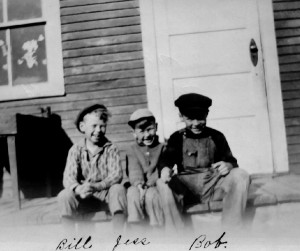
Bill, Jess, and Bob Tabor on Loon Lake School
Steps in 1931. "Picture Miss Herman took of
you one morning. Someday you will prize it.
Gram T."[Bill Tabor Collection]
Mrs. Emily LaRock Langford taught at Dayton the 1932-33 school year for $630. The prior year she taught at Polson for $1050 so country school teacher wages have long been lower than the town teacher wages. Mrs. Langford next taught at Valley View and finished teaching in Lake County in 1935 at Ronan. Bill Tabor remembers they, "Had to pack water for the school every morning from where my grandad lived." Bill said that Mrs. Langford kept him after school:
So I told Johnny (Vinson) to get my saddle horse and tie it right by the school porch. So when the teacher wasn’t looking, I ducked out and jumped on my saddle horse and took off for home. . . But there was always another day.
Registers show Irene Hafdahl teaching nine students in 1934-35 for $594 for the school year. In 1935-36 she taught six students for $630 for the whole school year. The students were: Robert, William, Jesse, and Dick Tabor; Amy and John Vinson, Jo Wishart, and Dick McBroom. Irene Hafdahl Daley says she lived at the J. L. Tabor home both years she taught. J. L. Tabor and Leon Tabor were both trustees. The Tabor property was just west across the road from the school. Irene Hafdahl wrote, "As I remember, I taught for $50 a month and was glad to have a job." Miss Hafdahl also taught at Sunny Slope and Garcon Gulch. Irene’s teaching career ended in 1937 when she married Forrest Daley. She currently lives in Kalispell. Bill Tabor remembers Miss Hafdahl playing baseball with a "little baseball bat with the handle broke off. Once when she swung at the ball, she let go of the bat and it went right over Johnny Vinson’s head. . . Just missed hitting him!" When they played baseball they didn’t have baseball bats or balls. They would use boards or sticks or an axe handle and a tennis ball. Amy Vinson remembered once when they were playing baseball, she was on second base. Johnny was up to bat and really hit the ball hard -- hit her right in the eye. She never forgot that! Bill attended Loon Lake up through the sixth grade. He attended Big Arm for the seventh grade and went in to Polson for the eighth grade and high school. Bill Tabor and Johnny Vinson were classmates and remembered a few stories about each other. Johnny tells this on Bill’s year with Miss Hafdahl:
He was full of mischief. Bill was ten or twelve and he and Miss Hafdahl got into it. She kicked him out and told him he had to take a note home to his parents, and come back with them and apologize before he could come back to school. When I went home I came across Bill up on the hill and he had built a little campfire and was sitting there singing, "Home On The Range." Guess he was maybe not in too big a hurry to get home.
Another time she kicked him out and I don’t know how he did it but he snared a ground hog. He threw it in the school window. Everyone was running and screeching around and the teacher told someone to catch it and get it out. Bill’s brother said, "Oh no! Don’t touch it. It’s poison." Jesse got it out.
The 1936-37 school year was the last year of school at Loon Lake District 42. Gertrude Davis taught three children: Johnny and Amy Vinson and Jim McBroom. Johnny tells about playing volleyball in the school building:
It was the last year the school was open and I was in the 8th grade. Teams were two kids against one kid and the teacher. Game got so wild, we broke two or three windows and knocked the globe down and broke it. It sure was fun though!
He remembered calmer, more academic moments as well. For instance he had to go to Polson to the courthouse to take his eighth grade exams to be able to graduate. And:
When we had an assignment – or had to memorize something to recite the next day, I would get up and leave in the dark to get to school by 7:00 a.m.. When we finished our lessons for the day we could go home. A lot of the time I got home by 12:00.
By March 19, 1940 the Loon Lake School District consolidated with Big Arm District #65. Big Arm would also be abandoned by 1962 and become part of Polson School District No. 23.
Much of Big Arm’s history was written by Roberta Culp for In The Shadows of the Missions and we have used this excerpt:
When the homesteaders claimed their 40 to 160 acre farm units in Big Arm in 1910 and 1911, there were about six or seven families of Indians already settled. People came from all parts of the world, speaking many dialects, including the Flathead, Kootenai, Blackfoot, and Cree Indians. The townsite of Big Arm came into existence with a rush after Polson and some of the other reservation towns were established. All supplies came to Big Arm by boat from Somers. A lot slate was held by the government, and most of the lots sold for a good price. Over this area with checkerboard precision could be seen the survey stakes; most were wood, some were iron with shiny brass caps. The lots on the water front and those most suitable for business location sold like hot cakes as soon as the homesteaders began to move in. Residence lots went begging; some never sold. The surveyed townsite was 645 acres and the population was 640 people. The U.S. government had set aside one-half mile square for a townsite, giving it the name of Big Arm because it lay on the "big arm" of Flathead Lake.
Neatly tucked away in the same valley with Loon Lake district is Big Arm district. Residents of the nearby Loon Lake District and Big Arm cooperated in building a Loon Lake school house. During that time Big Arm children attended school in one of the churches. The government provided an early school for Indian children, but that was dropped when all the kids attended classes in the new Big Arm two-room schoolhouse. Mr. William Howe, a veteran of the Spanish War, was Big Arm’s first school teacher, as well as freight agent for the boat companies and farmers. Mrs. Howe, also a veteran of the Spanish War, was a trained nurse and artist.
Mr. and Mrs. Adam Retz helped the schools in whatever way they could. Others active in the districts included Mr. and Mrs. Claude Brownell, Mr. and Mrs. Frank Ebel, Kyle Foster, Mr. and Mrs. John Baumert, Mr. and Mrs. Tozier, Miss Meta Steer, who later married Mr. King, John McGram, Pat Quigley, the proud possessor of claim number one in the Flathead Indian Reservation, Jenavieve Weil, Fred Bauchman, Mr. and Mrs. Sailie, who sold to Dr. Miller, Mr. and Mrs. Dad Harsh, Mr. and Mrs. Gardener, and Mr. and Mrs. Hobbs.
The Rude family of Big Arm long served the schools. Jennie and John O. Rude were united in marriage on October 19, 1884 in Minnesota. This union was blessed with 10 children. In 1910, Mr. and Mrs. Rude came to the Flathead Valley to make their new home, living first at Bigfork and then at Big Arm. J. O. Rude served as an early school trustee for over five years from 1912 to 1918. Harry Rude long served as district clerk. Albert Rude was a trustee in 1922. Mabel Rude served as district clerk at least seven years. Ida Rude taught from 1929 to 1933. Pauline Rude was clerk from 1945 to 1948. James Rude was a trustee from 1950 to 1953. John Rude passed away in October, 1921 and Mrs. Jennie Rude remained at Big Arm until her death in 1947.
The Reverend Elder served in church and as a school teacher for two years from 1914 to 1916.
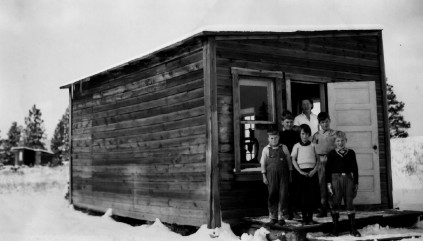
Big Arm School in 1935 L to R: Sid Walker, Gale Warren, Inez
Walker, Wes Vert. Teacher Louise Senft
By 1935 the regular school building within Big Arm townsite was closed. However, five students attended class in a one-room clapboard building, three miles east of Big Arm. Sid Walker attended this "old shack school" as a temporary site for about two years. There was a school boundary dispute and the school above was closed throughout the dispute. His first two grades were in the shack school and the rest in the larger Big Arm School. Glenn Walker taught in the little shack in 1934-35 and Miss Louise Senft taught five students in 1935-36. Sid remembers, "We had a woodhouse out back. I remember wanting to be bigger because the bigger boys got to get out of classes to split and haul wood. I could hardly wait!" Other memories include a school bell that could be heard all around, building snow tunnels once the snow crusted, a small school library, and very little to do. Throughout Sid’s years at Big Arm the attendance varied from five to twenty students. Sid vividly remembers the coffee pot incident with Teacher Paul Syverson who taught the 1939-40 school year. Mr. Syverson used a one gallon honey bucket as a coffee pot everyday. He had clamped the lid on tight and put it on to heat. The pressure built up and the lid hit the ceiling. One girl said she got hot coffee spilled on her but the worst was the terrible stain the coffee made on the white calcimine ceiling. Every time it was repainted it would not be long and the stain would come through. Sid wonders if it is still visible.
Louise Elizabeth Senft was a local lady who attended eight grades at Proctor as Louise Nelson. She attended high school in Kalispell. Then attended normal school and earned her teacher’s certificate. She started teaching at 18 years of age and taught both in Dayton and three years at Big Arm. Louise Elizabeth Senft died in Sandpoint, Idaho at nearly 90 on March 6, 1999.
Hazel Montgomery Lenoir attended Big Arm School from the first through eighth grades from 1940 to graduation in 1949. Enrollment was small most of those years with 1944-45 school year having only five students: Hazel and her two brothers Martin and Alvin, sister Betty and Teacher Marie Twitchel’s brother Tommy Twitchel. Hazel wrote:
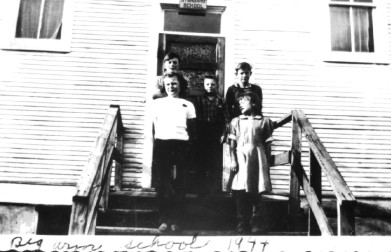
Big Arm School in 1944 Front: Hazel and Betty Montgomery;
Back: Martin Montgomery, Tom Twitchel and Alvin
Montgomery [Hazel Lenoir Collection]
There was a shortage of teachers due to the war and high school graduates were allowed to teach after a three-month training after graduation. Looking back, it must have been difficult for her with so little training and being so young. She had never lived away from her parents St. Ignatius home before and being so young, her parents insisted her brother go to Big Arm with her.
Other memorable teachers were Maggie Lannen; probably one of the best teachers Big Arm ever had, but a bit absent-minded. She would come to school with different colored stockings or blouse buttoned wrong and once came with her skirt caught up in the back of her underwear! She never had any children of her own but knew how to bring out the best in her students. (Sid Walker also agrees she was "better than most with discipline, which we rowdy boys needed. She made it interesting and kept us in line.") Grace Linse was a favorite of mine. She lived in Ronan and went home on weekends to be with her family.
The schoolhouse was one big room with a large entry that went the width of the building. We called it the Hallway. We hung our coats out there and extra desks and books were stored there. The school had no running water so of course we had outdoor toilets. Water was hauled in cream cans for drinking and washing hands. There was a dipper that everyone used to get a drink. Not very sanitary but we didn’t know the difference. The school was heated with a big wood stove and hot lunch program consisted of bringing soup in a jar to be heated at noon in a big pan of water. In the winter, if you forgot and left it in the hallway with your coat it was apt to be frozen by lunchtime. Of course, you didn’t dare put it in the hot water until it had thawed. I remember a few broken jars because we were too impatient. Big Arm also got some food from the government, I don’t know if it was a school lunch program or food surplus. Two things that have stuck in my mind are raisins and grapefruit juice. The raisins because I loved them and the canned grapefruit juice because it was so sour and bitter. No one would drink it and the teacher finally divided it between families and sent it home with us. Our mothers probably couldn’t get us to drink it either!
We had the flag raising ceremony every morning, with the pledge of allegiance. It was quite an honor to be selected to take care of the flag. It was put up in the morning and taken down at four when school was dismissed, folded correctly and carefully put away. On Friday just before time to go home we cleaned the schoolroom. Black board and erasers were cleaned; oiled sawdust was sprinkled on the wood floor and swept up. Wastebaskets were emptied and desks had to be neat and tidy and lined up in a row. At recess and noon when the weather was good some of the games we played were softball, pump-pump-pull-away, Red Rover, Green Light Red Light and Kick-the-Can. In winter we built snow forts for snowball fights, made snowmen and played Fox and Geese.
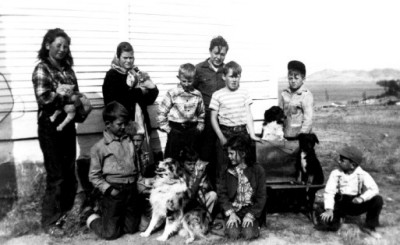
"Bring Your Pet to School Day" September 18, 1950 L-R
Front: Bobby McBroom, Willy Montgomery, Joanie Vinson,
Alice McBroom, Artie Rude; Back: Grace McBroom, Betty
Montgomery, Jerry Rude, Tom Antiste, Perry Price and George
Vinson [Hazel Montgomery Lenoir Collection]
We had the usual holiday parties but the Christmas program was the highlight of the year, with a play, Christmas Carols and poetry, etc. We practiced every Friday afternoon for at least six weeks to prepare for the Christmas program. Santa Claus would arrive at the end and hand out bags of candy and nuts to every one, even the adults got a bag of candy. We made Christmas gifts to give our parents. Some that I remember were crushed egg shells glued to nice shaped jars and painted with gold paint, cigar boxes decorated with macaroni and painted gold and a length of two-by-four with three holes drilled for candles, and chicken wire attached to hold red candles and fir boughs.
Sid Walker remembers those Christmases with candles snapped onto the trees that were lit for only a few minutes. People kept a good eye on them. There was always a big turnout without people you hadn’t seen all year. Winter was ice skating time on the bay – even the old ladies in long skirts skated until dark. Everyone used to get out and skate. Some had those big long blades. We used to get together and have a good time for the holidays. Sometimes Dad took us the three miles to school with a sleigh and team during the winter. Most of the time we went by Model T, our school bus.
One fall we had a pageant about the first Thanksgiving. I wore a beautiful beaded buckskin dress borrowed from the Couture family, so I must have played Pocahontas. We made a stage with bed sheets on a wire for the curtain. It was fun and entertainment for the whole community. In the spring we practiced for the annual track meet with Rollins, Proctor, Dayton, and Elmo. Our eighth grade graduation was also combined with the other West Shore schools.
Roy and Richard Couture graduated eighth grade with me. Others I remember attending Big Arm were Dick and George Vinson, Gracie and Alice McBroom, Perry Price, the Kipling girls, Ensinger boys, Bernard and Leo Eneas and Tom Antiste, Frankie Thompkins, the Walkers, Jerry and Artie Rude whose mother taught the 1947-48 school term, and Bobby McBroom. I have many good memories of the Big Arm community and the little one room school.
Essie Leona McDonald graduated from high school in Lenapah, Oklahoma in 1921. After attending normal college she taught in Enid, Oklahoma. On March 5, 1923, in Independence, Kansas, she married Thomas A. Seibert, a prominent Oklahoma educator. Seibert’s came west to the Dalles, Oregon, where Mr. Seibert taught on the reservation. In 1949 Seibert’s she came to Big Arm where Essie taught in the one-room school for three years. She later taught at Elmo and then St. Ignatius. On June 9, 1998 Mrs. Seibert passed away at St. Luke Extended Care in Ronan at the age 96.
The high school consolidation to Polson caused a bit of a stir in February 1949. Ronan District #28 petitioned the commissioners to review high school districts. With growth on the West Shore Polson District #23 taxpayers were carrying all their building costs while serving the whole West Shore for high school. Small districts did cover bussing costs. Dayton called for a joint meeting of the Big Arm and Dayton boards on February 22 hoping to oppose the high school reorganization. They feared further consolidation of the elementaries in the future and little to no representation once part of Polson. The motion was made to send District #65 high school portion to Polson. It passed ten to six. So by February 23, 1949 the West Shore High School district was consolidated with Polson High School District #23.
In 1950 three Big Arm Eighth Grade Graduates: Robert Choate, Bradley Ensinger, and Richard Vinson were presented diplomas by Lake County Superintendent of Schools J. B. Kiracofe in joint ceremonies with Elmo, Dayton, Proctor and Rollins at the Proctor School House. Big Arm students recited the "Kentucky Philosophy."
The consolidation issue with Polson continued. By the February 4, 1952 Clerk Hazel Vinson recorded this issue at the Big Arm Board Meeting:
. . . the subject of moving the school into Polson in an effort to lower taxes and solve the bus problem. James Rude made a motion to call a community meeting to find out how everyone felt about it and to take a tentative vote, if necessary. Motion was seconded by Bob McBroom. It was agreed that the board would look into the matter thoroughly and get all of the figures and facts to put before the people at such meeting.
The open meeting was held March 10, 1952 with all board members and clerk present with Mrs. Bartlett (?) to present information and answer public questions:
The Polson board had offered to take the Big Arm pupils for $100 each tuition -- plus their state money -- also to take any extras who may move in on the High School bus -- Big Arm to transport all possible (figured on 10) to Polson. Figuring that it would be possible to get a bus for $2500 she showed the people that the school could be sent to Polson for 20 mills, where, if they remain here it would be 35.23 mills. She showed them the amount of extra mills that would have to be raised to continue with the bus at Big Arm another year and how they would save 15 mills by sending them to Polson. Vote was taken -- Big Arm 23 -- Polson 20.
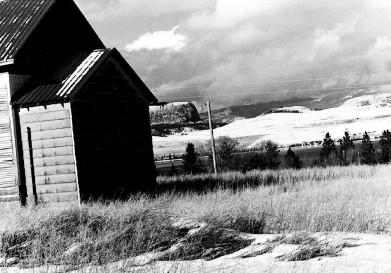
From Back of School looking towards Chief Cliff over the Big Arm of Flathead Lake [Sidney Walker Photo]
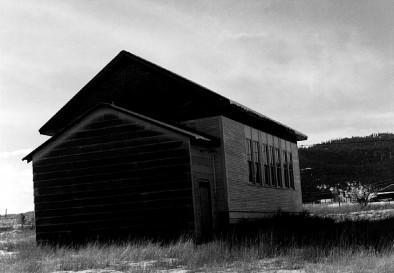
The window side of Big Arm School [Sid Walker Photo]
Big Arm 1952 students joined with Elmo students to sing "It Is No Secret" and "That Lucky Old Sun" for the graduation ceremony held that year with Big Arm, Elmo, Dayton, Proctor and Rollins. Big Arm graduate Betty Montgomery performed "Wit Weather Talk". George Vinson also graduated from Big Arm eighth grade in 1952. Mrs. Seibert was their teacher.
The board then held a meeting at which they asked Mrs. Seibert to teach the ‘52-53 term. Mrs. Seibert asked for a raise, which cannot be given without voting more millage as the present budget is already as high as it can go. It was decided that a special election would be held to vote on levy’s for raise in teacher’s salary and transportation.
A special May 9, 1952 board meeting was held to deal with the failure of the voted levies. Bob McBroom moved and Ed Hoyt seconded "that the pupils be sent to Polson the next term if a bus could be contracted at a reasonable figure -- inasmuch as the levy for the increase was voted down at the election." Big Arm students were thereafter bussed to Polson.
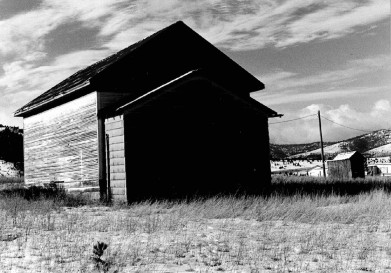
Backside of Big Arm School with Boys and Girls
Privies in sight. [Sid Walker Photo January, 2000]
Some furnace problems, disputes over who would ride the Big Arm school bus, some new desk concerns and regular election and budget business consumed board meetings over the next months and years with annual letters to Polson to request acceptance of Big Arm students and agree on tuition. With the school closed board meetings were held in the home of the clerk to save heating and utility costs. This continued until Big Arm School District #65 was officially abandoned July 2, 1962.
A back addition was added at some point and the siding never got completely painted. A red metal roof replaced the old shakes. The green shakes on the gables are fading but are still attractive with the red roof line trim. Since 1973 the abandoned school was long used by the community’s Harmony Club followed by a couple years of use from the Railroad Club. They leased it from Polson School District Number 23 for one dollar a year. Today the locked school and its two outdoor privies top the grassy hill unused. The Polson board has not yet considered selling the building and site as there is no sewer hookup or indoor plumbing. The schoolhouse windows still gaze northeastward looking towards Chief Cliff over the Big Arm of Flathead Lake
